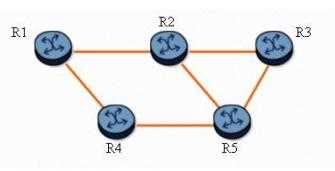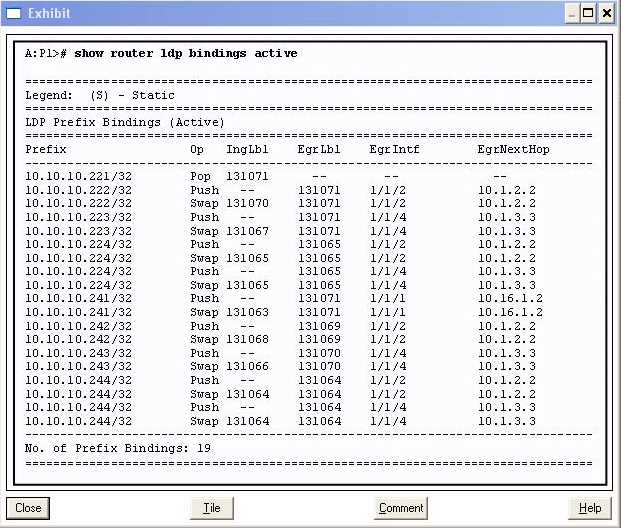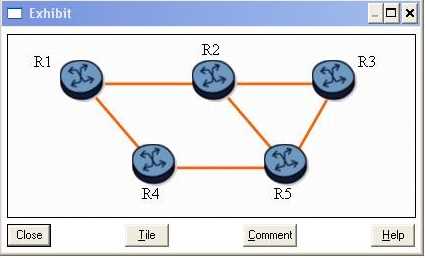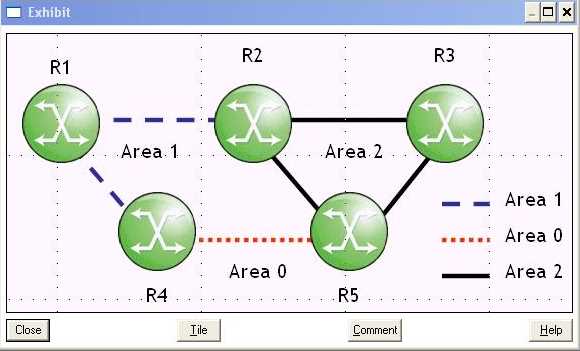nokia 4a0-103 practice test
Nokia Multiprotocol Label Switching
Question 1
You wish to advertise LDP labels for all local networks; which is the most effective policy statement to
use?
- A. from prefix-list direct
- B. match local
- C. from protocol direct
- D. match protocol direct
- E. from protocol local
Answer:
C
Question 2
Which of the following indicates the path over which an LSP's tail end router will return an RSVP
RESV message?
- A. The IGP FIB.
- B. The Reservation State Block (RSB)
- C. The Path State Block (PSB)
- D. The opaque database.
Answer:
C
Question 3
Click on the exhibit button below.
With fast reroute enabled, and given the following:
Two protected LSPs with the path R1-R2-R3
Both LSPs enable facility bypass and link protection.
When router R1 is the PLR, which router becomes the MP?
- A. Router R1
- B. Router R2
- C. Router R3
- D. Router R4
- E. Router R5
Answer:
B
Question 4
Click on the exhibit button below.
Given the output below, which of the following statements are true? (Choose three)
- A. A packet arriving with label 131066 and destined for prefix 10.10.10.243/32 will be forwarded out interface 1/1/4, with label 131070.
- B. LDP ECMP is enabled.
- C. The router’s system address is 10.10.10.242/32.
- D. There are multiple LSPs to reach FEC 10.10.10.244/32.
- E. The router cannot receive any unlabeled packets destined for prefix 10.10.10 223/32.
Answer:
A, B, D
Question 5
Which of the following statements best describe MPLS fast reroute characteristics? (Choose two)
- A. Fast reroute requires you to manually define detour paths.
- B. Fast reroute provides path protection close to the failure point
- C. Fast reroute performs automatic path calculation and signaling.
- D. Fast reroute protects both primary and secondary paths.
Answer:
B, C
Question 6
During node protection signaling, the PLR knows the address of the MP from which of the following
methods?
- A. The PLR issues a RSVP path message to the destination router to request the address of the MP.
- B. The PLR learns the address of the MP from the ERO.
- C. The PLR learns the address of the MP from the RRO
- D. The PLR learns the address of the MP from the targeted RSVP hello message.
- E. The PLR does not need to know the address of the MP.
Answer:
C
Question 7
What is the significance of receiving a packet with the bottom MPLS label S bit set to 1?
- A. It results in forwarding based on the next packet header.
- B. It indicates that the label is the bottom of the MPLS label stack.
- C. It indicates that the label is the top of the MPLS label stack.
- D. Any LSR that receives an S bit set to 1 must discard the packet.
Answer:
B
Question 8
Which command can be used to verify the LDP settings for label distribution and retention?
- A. show router ldp default
- B. show router ldp parameters
- C. show router ldp settings
- D. show router mpls settings
- E. show router mpls label-options
Answer:
B
Question 9
Router R3 signals an LSP, reserving 1Gbps bandwidth on a 10Gbps link. RSVP configuration limits
reservable bandwidth to 20 percent on the egress interface. Which of the following statements is
true?
- A. The egress RSVP interface has 80 percent bandwidth unreserved.
- B. LSPs can reserve an additional 9.9 Gbps bandwidth on this RSVP interface.
- C. The head end reserves 100Mbps for the LSP
- D. The egress RSVP interface has 1 Gbps bandwidth unreserved.
Answer:
D
Question 10
Click on the exhibit button below.
Assuming that LSP R1-R2-R3 requests the default fast reroute configuration, which router becomes a
DMP for the detour tunnels?
- A. Router R1
- B. Router R2
- C. Router R3
- D. Router R4
- E. Router R5
Answer:
E
Question 11
Which of the following message types does RSVP use to set up an LSP? (Choose two)
- A. Path message
- B. iLER message
- C. Resv message
- D. LSP setup call request
- E. eLER message
Answer:
A, C
Question 12
Assume that, on the Alcatel-Lucent 7750 SR, an LSP is configured with one-to-one FRR and node
protection. Which of the following statements are FALSE? (Choose two)
- A. Each PLR signals a detour LSP that avoids the downstream node. If the downstream node cannot be avoided, a detour LSP that avoids the downstream link is signaled.
- B. The detour LSP can take one or more hops before merging back on the protected LSP.
- C. The merge point of the protected LSP must be the next-next-hop node
- D. The ingress router will set the local protection desired flag in the session attribute object of the path message to inform all routers along the protected LSP path to establish detour LSPs.
- E. The label recording desired flag must be set in the session attribute object in order for the PLR to know what label to swap when using the detour LSP.
Answer:
C, E
Question 13
Click on the exhibit button below.
With fast reroute enabled, and given the following:
The protected LSP path is R1-R2-R3.
All links are of equal cost.
Which of the following statements is true? (Choose two)
- A. Router R1 is the LSP originator and is also a PLR.
- B. With one-to-one link or node protection, the detour LSP path is R1-R4-R5-R2-R3.
- C. With one-to-one link or node protection, the detour LSP path is R1-R4-R5-R3.
- D. If the R2-R3 link fails, router R3 becomes a PLR
- E. None of the nodes can be protected with FRR.
Answer:
A, C
Question 14
Which of the following statements regarding LSP path configuration are true? (Choose three)
- A. The path must include at least one hop.
- B. The path may be used multiple times in a single LSP.
- C. The path may comprise loose hop entries only.
- D. The path must define the LSP's tail end.
- E. The path may be used for multiple LSPs.
Answer:
C, E
Question 15
Click on the exhibit button below.
Consider the following:
Routers R1 and R4 are in Area 1.
Routers R4 and R5 in Area 0.
Routers R5 and R3 are in Area 2.
To support LDP-over-RSVP tunnels between routers R1 and R3 over path R1-R4-R5-R3, with which
routers will router R5 require targeted sessions? (Choose two)
- A. Router R1
- B. Router R4
- C. Router R2
- D. Router R3
Answer:
B, D